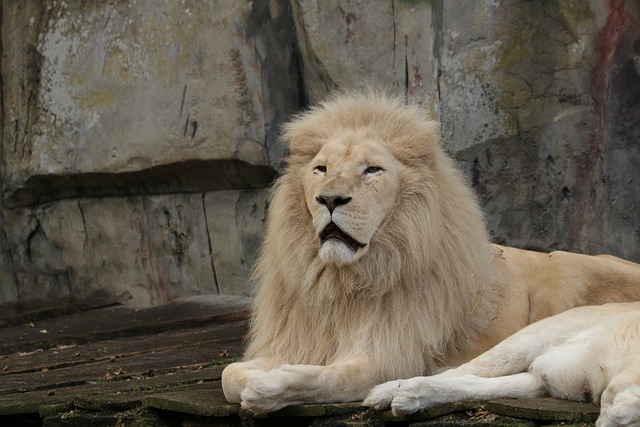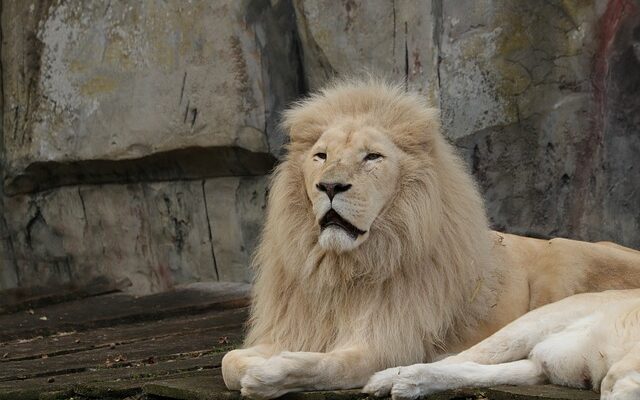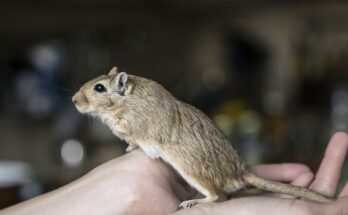Introduction:
The Asiatic lion, known for its regal presence and symbolic significance, is an awe-inspiring creature that has captured the imagination of humans for centuries. While the standard golden coat of the Asiatic lion is synonymous with its identity, there exists a rare and mystical variant known as the White Asiatic Lion. This unique subspecies is a living testament to the diversity of nature and the enigmatic beauty that lies within the animal kingdom.
Origins and Habitat:
The Asiatic lion (Panthera leo persica) once roamed across a vast expanse, from the Mediterranean to the northeastern parts of the Indian subcontinent. However, due to habitat loss, hunting, and human-wildlife conflict, the population drastically declined. Today, the last surviving population of wild Asiatic lions resides in the Gir Forest National Park in Gujarat, India. Within this population, a small number exhibits the rare trait of a white or cream-colored coat.
Distinctive Features:

The White Asiatic Lion, also known as the White Gir Lion, stands out not only due to its unusual coat color but also because of its physical magnificence. Like its golden counterparts, it possesses a well-muscled body, a broad head with a distinctive mane, and a long tail with a tuft of hair at the end. The white coat, ranging from creamy white to nearly pure white, sets it apart from its more common counterparts. This unique coloration is a result of a genetic mutation that affects pigmentation.
Genetic Anomalies:
The gene responsible for the white coat in Asiatic lions is a recessive trait. Both parents must carry the gene for there to be a chance of producing a white cub. When two lions with this recessive gene mate, there is a 25% chance of their offspring being white. This rarity adds to the mystique surrounding the White Asiatic Lion and highlights the delicate balance of nature that results in such extraordinary phenomena.
Conservation Challenges
The conservation of the Asiatic lion, including its rare white variant, faces numerous challenges. The small and isolated population in the Gir Forest National Park is susceptible to diseases, natural disasters, and genetic issues due to a limited gene pool. Initiatives such as habitat protection, anti-poaching measures, and community involvement are essential to safeguard the future of the White Asiatic Lion.
Symbolism and Cultural Significance:
Throughout history, lions, with their majestic presence, have been revered in various cultures. The White Asiatic Lion, in particular, holds a special place in the hearts and minds of those who encounter its rare beauty. In Hindu mythology, lions are associated with the goddess Durga, symbolizing power and protection. The presence of the White Asiatic Lion in Indian folklore adds an extra layer of mysticism and reverence to this already magnificent creature.
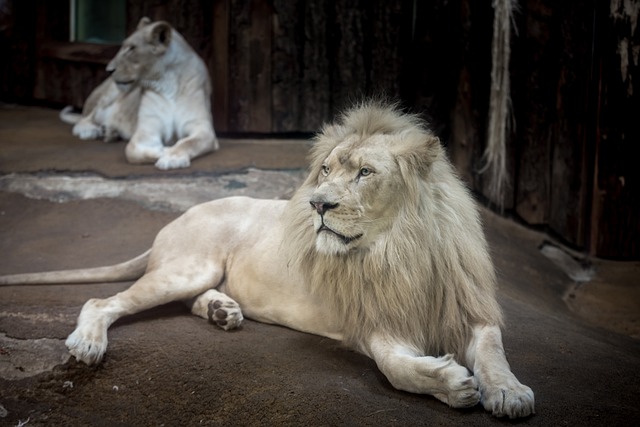
Tourism and Ecotourism:
The Gir Forest National Park has become a haven for wildlife enthusiasts and tourists seeking to catch a glimpse of the Asiatic lion, including the elusive white variant. Tourism, when managed responsibly, can contribute to the conservation efforts by generating funds for park maintenance and community development. However, it is crucial to strike a balance between promoting tourism and ensuring the well-being of the lions and their habitat.
Global Awareness and Education:
Raising awareness about the White Asiatic Lion is pivotal to garnering support for its conservation. Educational programs, documentaries, and community outreach initiatives can play a significant role in fostering a sense of responsibility toward the preservation of these magnificent creatures. By understanding the importance of biodiversity and the delicate ecosystems in which these lions thrive, people worldwide can contribute to their survival.
Conclusion:
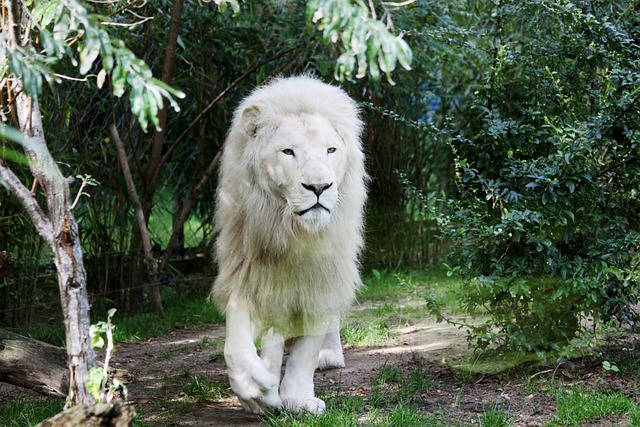
The White Asiatic Lion stands as a living testament to the wonders of the natural world and the need for concerted conservation efforts to ensure its continued existence. As a symbol of strength, grace, and rarity, this magnificent creature deserves our admiration and protection. Through responsible tourism, conservation initiatives, and global awareness, we can collectively contribute to preserving the legacy of the White Asiatic Lion for generations to come.we not only ensure the survival of a rare subspecies but also contribute to the preservation of our planet’s rich biodiversity.
Unraveling the Mystery
In the heart of the Gir Forest National Park, a place steeped in natural beauty and biodiversity, resides one of the world’s rarest and most captivating big cats—the White Asiatic Lion. This elusive subspecies, a variant of the more commonly recognized golden Asiatic lion, has sparked fascination and wonder among wildlife enthusiasts, conservationists, and researchers alike.
Phenomenon of Whiteness
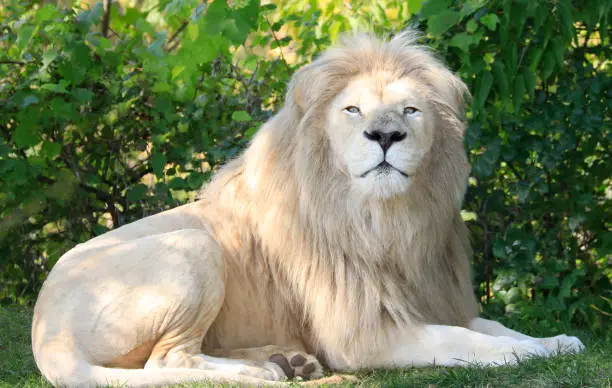
The enchanting white coat of the Asiatic lion is a result of a genetic anomaly that affects pigmentation. The responsible gene, a recessive trait, leads to a reduction or absence of melanin, the pigment responsible for the typical golden hue of the lion’s fur. This genetic quirk gives rise to a spectrum of colors ranging from creamy white to nearly pure white. The rarity of this gene and the resulting white lions make them a unique and precious part of the natural world.
Genetic Inheritance and Breeding Challenges
Breeding white Asiatic lions presents a unique set of challenges due to the recessive nature of the gene responsible for their distinctive coloration. Both parent lions must carry this recessive gene for the chance of producing white offspring. This complexity in genetic inheritance emphasizes the delicate balance required for the perpetuation of the white variant. As conservationists work towards ensuring the survival of the Asiatic lion population, maintaining genetic diversity, and carefully managing breeding programs become paramount.
Adaptations and Survival
Despite their ethereal appearance, white Asiatic lions are not hindered by their unique coat color in the wild. In fact, their survival hinges on the same adaptations that allow their golden counterparts to thrive. The broad head, powerful limbs, and sharp claws, characteristic of all Asiatic lions, enable them to navigate their natural habitat successfully. However, the white coat might present challenges during hunting, as it does not provide the same camouflage in the grasslands of Gir National Park. Nevertheless, these lions have evolved to overcome such hurdles through heightened stealth and keen senses. Read more
FAQS:
The white lion is a rare colour mutation of the lion, specifically the Southern African lion. White lions in the area of Timbavati are thought to have been indigenous to the Timbavati region of South Africa for centuries, although the earliest recorded sighting in this region was in 1938.
The Asiatic lion, also known as the Persian lion, is a population of Panthera leo leo that today survives in the wild only in India. Since the turn of the 20th century, its range has been restricted to Gir National Park and the surrounding areas in the Indian state of Gujarat
There are currently less than 13 White Lions living in the wild. Interestingly, this coincided with our introduction of Marah and her cubs into free-roaming bushveld conditions in the heart of their endemic territories.
Asiatic lion
The Asiatic lion (Panthera leo persica) is a subspecies of the lion which today survives only in India. Asiatic lions stand at between 1 and 1.2 metres tall. They are the most sociable of the big cats, led by a dominant male who is the only male in the pride who can mate.
As the commercial trophy hunting of lions continued in this region, the White Lions finally went extinct in the land of their origins. In 2004, after 12 years of technical extinction of the White Lions in their ancestral homelands, the Global White Lion Protection Trust commenced its reintroduction program.
Just how unusual are white lions? Only about a dozen exist in the wild today. That’s according to the Global White Lion Protection Trust, which was founded by South African conservationist Linda Tucker in 2002 to help protect white lions and reintroduce them into the wild. White lions are not balbinos.